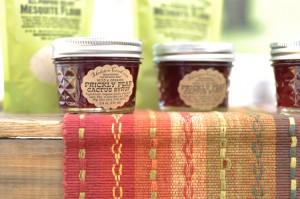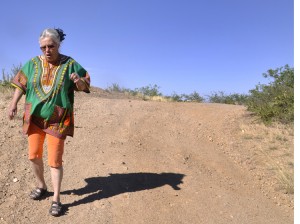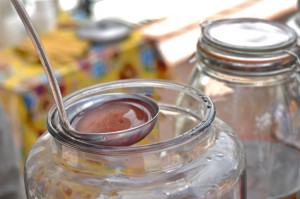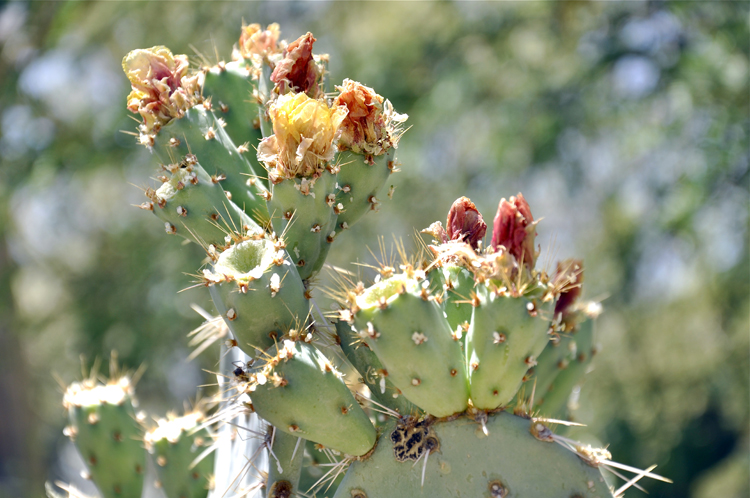Fruit grows prolifically in Tucson. Oranges and grapefruits, limes and kumquats are all cultivated. But one crop that residents are passionate about is the plant they didn’t plant, and it is everywhere: the prickly pear cactus.
A green cactus, officially called the Opuntia, whose flat leaves are edible, produces the magenta fruits that yield bright purple juice. The prickly pear appears dangerous, with clusters of tiny needles and long spines.

Vendors at the farmers market at St. Philip's Plaza use local prickly pear to make syrup and other food products. Arielle Dollinger | NYT Institute
It is called the prickly pear for a reason.
And yet, it is in lemonade and margaritas, in popsicles and jams, even in jellies and syrups. It’s an ingredient in purple taffy and burgundy soap, chipotle sauce and lip balm.
“It’s very, very important to our history and to our culture,” said Linda Wolfe, director of retail at Tohono Chul Park, a botanical garden in Tucson. “And it tastes really good.”
Wolfe stocks the park’s shops with 30 different prickly pear products, like candy, salsas, syrups and honeys.
“They’re delicious, they’re nutritious, and Native Americans have been enjoying them for thousands of years,” she said.
Many visitors to the Tucson area, Wolfe said, bring prickly pear items back for friends and family because it’s a novelty on the East Coast.
The park even sells prickly pear items made from fruit harvested on its grounds, said Marcia Ring, the park’s marketing director. The park’s garden bistro also serves prickly pear lemonade, prickly pear margaritas and prickly pear parfaits.

Natalie McGee harvests prickly pear cactus fruit from her 40-square-mile ranch in southern Arizona. The plant is said to have health benefits, which include fighting cancer cells. Arielle Dollinger | NYT Institute
Natalie McGee lives among horses and cattle and cactuses, across the street from a nasty and defensive dog.
The cactuses, which her livelihood depends on, grow amid the houses and the horses. They grow next to the cemetery and along the sides of the roads. They grow on the hillsides and the desert floor.
McGee, a former social worker, is the woman behind Arizona Cactus Ranch, a brand she created when she realized there was demand for a pure concentrated version of prickly pear juice.
“I began to understand that there was something very, very powerful in this food,” McGee said, recalling the start of her business in 1991. The plant is said to have health benefits, including lowering sugar and triglyceride levels and fighting cancer cells.
In August, when the purple fruits are ripe, McGee picks some herself and she pays people to collect more. She takes all of the fruit to her small juicing complex in Tucson.

Local vendors at St. Philip's Plaza use prickly pear cactus to make items such as prickly pear syrup, burgundy soap and lip balm. Arielle Dollinger | NYT Institute
Mike Mallozzi, president of Borderlands Brewing Co. in Tucson, uses McGee’s juice in the brewery’s prickly pear wheat beer — a sweet, carbonated, champagne-colored drink with a light, citrusy aftertaste.
At a farmer’s market at St. Philip’s Plaza, Jeau Allen sells prickly pear popsicles and jellies. She owns The Mesquitery, a business she cultivated around Sonoran Desert plants, including the prickly pear.
“It’s this novel concept, except for families who have been here for generations,” she said. “It’s still like, ‘Wow, you can pick that and eat it?’”
CORRECTION: This post has been updated to correct the name of the location of the farmer’s market where prickly pear products are sold. It is St. Philip’s Plaza, not St. Phillip’s Plaza.


 During the Institute, students are working journalists supervised by reporters and editors from The New York Times and The Boston Globe. Opportunities for students include reporting, copy editing, photography, Web production, print and Web design, and video journalism. Institute graduates now work at major news organizations, including The Associated Press, The Los Angeles Times, The Washington Post and The New York Times itself, and dozens of midsize news organizations.
During the Institute, students are working journalists supervised by reporters and editors from The New York Times and The Boston Globe. Opportunities for students include reporting, copy editing, photography, Web production, print and Web design, and video journalism. Institute graduates now work at major news organizations, including The Associated Press, The Los Angeles Times, The Washington Post and The New York Times itself, and dozens of midsize news organizations.